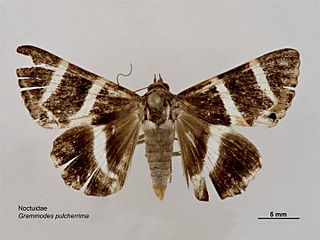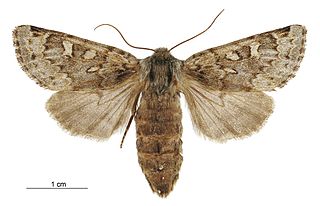
Macaria alternata, the sharp-angled peacock, is a moth of the family Geometridae. It is found in Europe, Turkey, the Caucasus, Georgia and South Siberia.

Macaria notata, the peacock moth, is a moth of the family Geometridae. It is a Holarctic species.
Laelapia is a monotypic moth genus in the family Erebidae. Its single species, Laelapia notata, is found in Madagascar. Both the genus and species were first described by Arthur Gardiner Butler in 1879.
Notata is a genus of moths in the subfamily Arctiinae.

Opharus is a genus of moths in the family Erebidae. The genus was erected by Francis Walker in 1855.
Holocryptis is a genus of moths of the family Noctuidae erected by Thomas Pennington Lucas in 1893.

Lomographa is a genus of moths in the family Geometridae. The genus was erected by Jacob Hübner in 1825.

Semiothisa is a genus of moths in the family Geometridae. It was erected by Jacob Hübner in 1818.

Jordanita is a genus of moths of the family Zygaenidae.

Grammodes pulcherrima, the comely box-owlet, is a moth of the family Noctuidae first described by Thomas Pennington Lucas in 1892. It is found in the northern half of Australia.

The Australian striped hawk moth is a moth of the family Sphingidae first described by the Scottish-born Australian medical practitioner, naturalist, author, philosopher and utopianist; Thomas Pennington Lucas in 1892. H. livornicoides was once a common food source for the Arrente community in Central Australia, however is not consumed anymore due to their sacredness and increasing scarcity. The local name for the caterpillar is 'Ayepe-arenye', often anglicised as 'Yeperenye' or 'Yipirinya'.
Eupithecia alliaria is a moth in the family Geometridae. It is found from France and the Iberian Peninsula east through south-central Europe to Russia and most of the Balkan Peninsula. It is also found in the Near East and North Africa.
Scrobipalpa notata is a moth of the family Gelechiidae. It is found in Ukraine and Russia.
Opharus notata is a moth of the family Erebidae. It was described by William Schaus in 1892. It is found in Brazil.

Notata parva is a moth in the family Erebidae. It was described by George Hampson in 1891. It is found in India and on Sumatra, Java, Bali, Sumbawa, Borneo and the Philippines.
Notata zumkehri is a moth in the family Erebidae. It was described by Rob de Vos and Henricus Jacobus Gerardus van Mastrigt in 2007. It is found in Papua New Guinea.

Mnesictena notata is a moth in the family Crambidae. It was described by Arthur Gardiner Butler in 1879. It is endemic to New Zealand.
Tricholita notata, the marked noctuid, is a species of cutworm or dart moth in the family Noctuidae. It is found in North America.

Ichneutica notata is a moth of the family Noctuidae. It is endemic to New Zealand. Although similar in appearance to other species in the Ichneutica genus, it can be distinguished by the colouration and patterns on its wings. It appears to be a very local species, rarely collected and having only been recorded in the north-west of the Tasman District, the Paproa Range, the Rainbow Ski field and the Craigieburn Range. Very little is known of the life history of I. notata.









